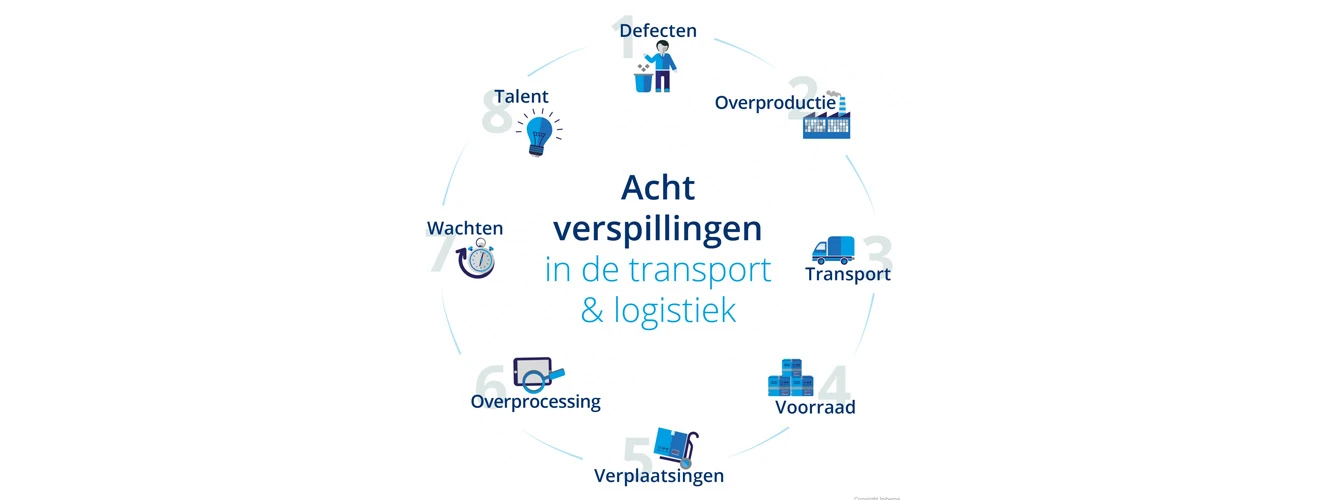Working more efficiently in transport and logistics

Providing customers with added value by putting in less effort
“It is not the strongest of the species that survives, but the one that is most adaptable to change” (Darwin). That couldn’t be further from the truth – even in the transportation and logistics sector, which faces complex challenges. Optimisation is therefore crucial, and efficiency appears at the top of many companies’ agendas.
When you refer to lean……you are essentially talking about continuous improvement. Lean allows you to streamline business processes, allowing you to adapt in a flexible manner and perform to the best of your ability in the long term. Systematic improvement, with the customer as the starting point, should ultimately deliver the power to innovate – and that’s exactly what futureproof entrepreneurship requires.
How lean is your transport en logistics process?
The first step towards a lean organisation is to gain insight into what value the organisation is actually delivering to the customer. The question then is how that value is created, what activities and resources are making an essential contribution in this regard?
Everything that doesn’t create value is a waste, or a futile activity. One of the main pillars of the lean way of thinking is that waste is eliminated. The lean way of thinking states that there are eight traditional forms of waste, which also occur in the logistics process.
1. DEFECTS (OR RECTIFYING THEM)
Customers expect their orders to be delivered on time and in good condition, despite last-minute changes, traffic diversions or material defects. You want to keep the cargo in good condition and prevent incorrect deliveries or other problems, which only results in time-consuming repair work, which no one wants. But how do you prevent waste caused by defects? The problem needs to be tackled at the source. Sometimes repeat (compulsory) training of your staff or preventative maintenance for the fleet will suffice, whilst at other times, it’s worth automating the process in such a way that as few dependencies as possible continue to exist. In all cases, the art lies in making faults virtually impossible.
2. OVERPRODUCTION
The king of waste. We think we often know what’s good for the customer and put our best foot forward…and then it turns out that putting our best foot forward has no effect on customer satisfaction whatsoever! Take offering a super-fast delivery time, for example: “Order today for same day delivery”. But who is to say that the customer needs it so quickly, is actually at home or has enough space to receive the delivery? It’s a pity about all that extra effort! So here we’re talking about waste that occurs as a result of overproduction, i.e. when more can be produced or delivered than what the customer requires.
3. INEFFICIENT TRANSPORTATION
Numerous extra kilometres travelled due to an inefficient schedule or route, an unexpected diversion or unnecessary stoppage – it’s not exactly efficient, cheap or environmentally friendly. The third type of lean waste concerns all extravagant forms of transport, but also fleets that aren’t used or maintained as well as they could be. A poorly maintained fleet doesn’t just result in higher stoppage times, but also in police arrests. It is common knowledge that both the BAG in Germany and the Dutch National Unit (LE) would rather stop a damaged truck than a well-maintained one. Even if you fail to meet the legal requirements for securing loads, you will be pulled over by the police. Assisted by smart software, it is becoming easier and easier to optimise things such as the loading capacity or the staffing of the cargo space – even during seasonal peaks or complex routes and deliveries.
4. UNNECESSARY AMOUNTS OF STOCK
How do you ensure that you have enough stock in your possession to deliver to your customers on time, whilst at the same time not dedicating too much time and money to storage space? Or how do you prevent the stock from getting lost? This area of tension is well known to many of us. The trick is to make choices based on what provides instant added value for the customer. Other types of waste resulting from the stock is the space it takes up or repeatedly moving the stock so that it doesn’t get in the way. You should do what you can to eliminate the causes, such as overproduction, forecast errors, too long a lead time and/or consider the risk in economies of scale.
5. UNNECESSARY MOVEMENTS
All movement that does not add value to the product or the process. Think about physical waste such as lifting, turning or reaching due to an ergonomic workplace that has been organised in an irresponsible manner. Or about unnecessary physical indicators, because you are looking for information, colleagues or equipment, for example.
6. OVERPROCESSING
Prevent double work, such as by bundling goods flows effectively. Carefully considering in advance how the process is organised is worth it later if the lead time can be reduced. The same applies to optimising the shipping and staffing level, thereby reducing waste in the process. Full truckloads by consolidating cargo rather than a large number small shipments are that little bit more efficient. Goods don’t need to be transferred en route, so there’s less risk of damage and unnecessary goods movements are prevented. LHVs have also made a positive contribution in this regard.
7. WAITING…
Waiting for equipment, people, decisions and all other things that lead to waiting times before we are able to do our work. For example, think about the number of questions you have asked to colleagues, suppliers and customers, or the waiting times when loading and unloading goods due to using the wrong equipment. A small adjustment means that a vehicle can easily be adapted for a different type of shipment, so that it can easily be unloaded at the side, for example. Waiting times: these are what kill our productivity; lose us time. Time that you would rather put into increasing your added value for the customer.
8. TALENT
Nowadays, wasted talent is a buzzword. Many people are working above or under their level. This a pity when it comes to knowledge sharing and acquisition, but may also cause employees to become dissatisfied.
The power of innovation thanks to a new routine
Lean isn’t a magic wand that will rapidly make an organisation operationally excellent, but a mindset. People act routinely 95% of the time, and creatively just 5% of the time. The big question is: How, as an organisation, do you ensure that you apply routine when seeking improvement?
That is what lean focuses on. Lean imparts a different view on organisations. It is a different way of looking. Activities that don’t create value, but do create time or energy costs, must be eliminated to give you space for things that the customer does deem to be important.


